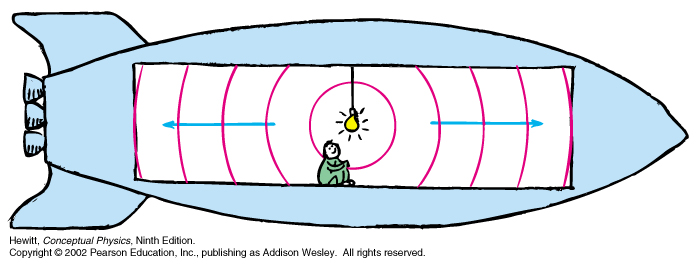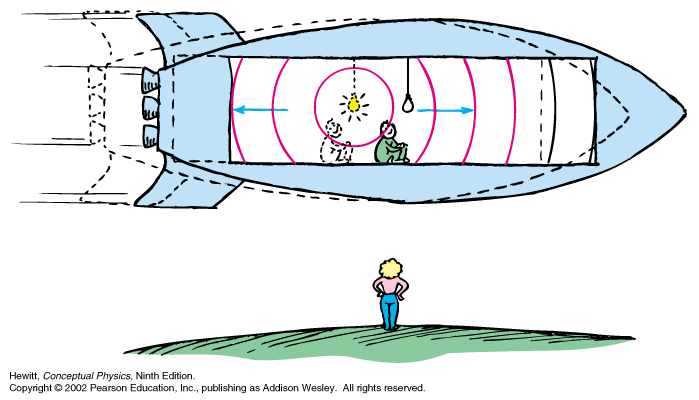Special Theory of Relativity
Lecture Notes by I. Bars
Einstein's Special Theory of Relativity describes the correct rules of physics for fast moving objects both in the macroscopic and subatomic world. It was developed by Einstein from two postulates which ended up being correct:
(1) (1) The laws of physics are the same in any inertial frame of reference (inertial means no external forces acting on the frame).
(2) (2) The speed of light in vacuum is always the same constant c irrespective of the speed of its source and irrespective of an observer static or moving.
The first postulate was assumed and used since Newtons time. The second, more daring, postulate was motivated by Maxwells prediction that light has a definite speed c=300,000 km/s as given by the electromagnetic wave theory of light. There was no room in Maxwells theory for different observers to see different values. Also attempts to define an absolute reference frame (the Ether) became untenable in the face of negative experiments by Michelson and Morley. However, the later does not seem to be the motivating factor for Einsteins postulate .
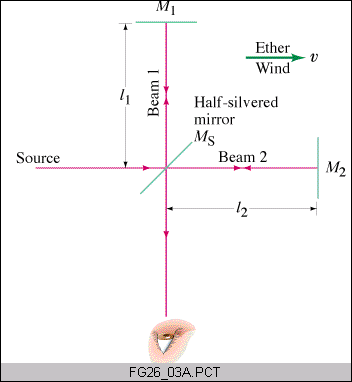
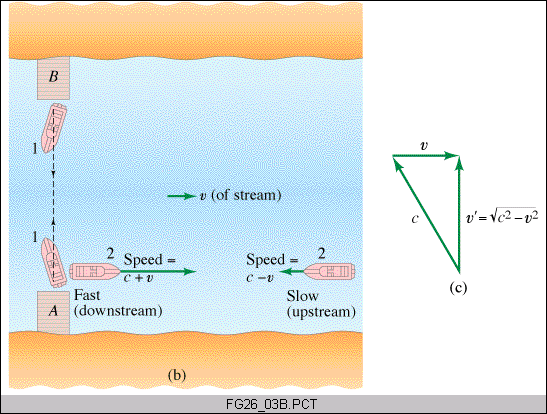
As consequences of the postulates, as seen by a static observer, the laws of physics in a fast moving frame may seem non-intuitive and surprizingly different than the ones in a static (or even a slow moving) frame, but all puzzles are explained by understanding the concepts of relative time and space, which undergo a revolution.
Relativistic addition of velocities.
It helps to see the correct relativistic formula for addition of velocities right at the beginning of the discussion, to remove the mystery of how the speed of light is always the same irrespective of observer or of source. This is counter-intuitive because it is unlike the relative motion of objects we observe in our everyday life (mainly slow moving objects).
If you throw a particle with a speed v1 from a spaceship moving at a speed v2, the total speed Vtotal as observed outside of the spaceship in the static frame is given by the formula in the box. Here v2 is the relative speed of the two observers. Positive or negative values for either v1 or v2 are taken depending on their directions.
|
Addition of velocities to a line |
Vtotal=(v1+v2)/(1+v1v2/c2) |
If v1v2/c2<<1 then Vtotal ≈ v1+v2 (everyday life) e.g. if v1=0 then Vtotal = v2 (picture below) e.g. if v2=0 then Vtotal = v1 (no relative motion) If v1=c then Vtotal =c for any v2 (light from ANY moving source) If v2=c then Vtotal =c for any v1 (ship at speed of light) |
The picture shows the case for v1=0 (object has no horizontal velocity relative to the car in case (a)), and any v2.
A static observer outside of the car sees object at Vtotal = v2. This is like everyday life.
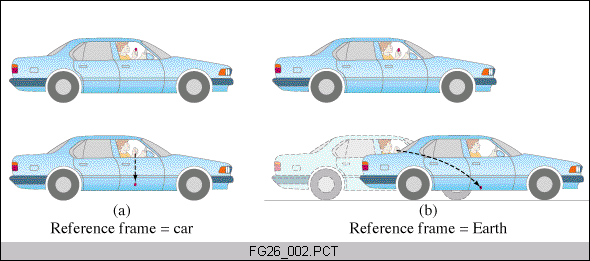
A fast moving rocket (#1) shoots a fast moving projectile (#2), what is the speed of #2 as measured by an observer on Earth?
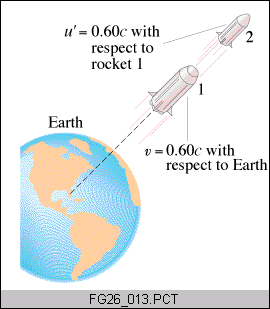
Vtotal=(v1+v2)/(1+v1v2/c2) = (0.60c+0.60c)/(1+0.60 x 0.60 ) = (1.20/1.36) c = 0.88 c
Simultaneity
What is a simultaneous event?
|
|
Light signals reach simultaneously both ends of the chamber of the ship as seen by the traveling observer |
|
|
From the point of view of the static observer the signals do not reach simultaneously the ends of the chamber because the ship is moving while light moves at the same speed in either frame |
The two observers do not agree on simultaneity. So simultaneity is not an absolute concept, and time measurements are not absolute or universal.
· · When you look out the window, the scene on your retina - the scene you see - is not all happening at the same moment.
· · The stars in a photo of the night sky were not all there looking as they do at the same moment, even though the light from them arrived on the film at the same instant.
· · If you see two stars explode at the same time, one of the events might have happened earlier to an observer from some other galaxy.
Time dilation
Now consider a beam of light as shown in the picture and observed from inside or outside the spaceship
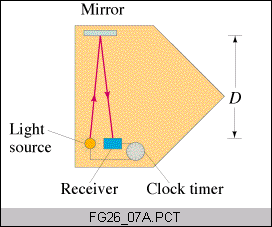
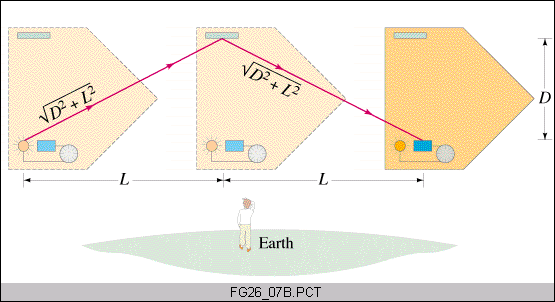
Light is observed at the same speed c in either frame. The observer in the ship and the static observer outside have identical clocks, but measure a DIFFERENT time lapse for the same event (emission - reception).
|
|
Observer on ship |
Observer outside |
|
Time = distance/ speed of light |
Δtship=2D/c |
ΔtEarth =2(D2+L2)1/2 / c ΔtEarth = Δtship / (1-v2/c2)1/2 |
A little algebra: The ship is moving at speed v, therefore 2L=vΔtEarth while 2D=c Δtship . Replace these to get ΔtEarth = Δtship [1+(v ΔtEarth)2 /(c Δtship)2] 1/2 , then square it, and solve as above. Or, use the right triagle up to midway (( c ΔtEarth /2 )2= ( v ΔtEarth /2 )2 + ( c Δtship /2 )2, and solve to obtain the same result.
Time Dilation: ΔtEarth is obviously larger since light travels a longer distance. It is what the observer outside measures on his static clock. Therefore as observed by the static observer, the static clock ticks FASTER as compared to the moving clock (or the moving clock ticks SLOWER as compared to the static clock).
So, an astronaut on Earth ages faster than an astronaut on a spaceship according to observers on Earth (biological clocks). The astronaut on the spaceship feels nothing different.
Twin paradox: Isnt the role reversed for the twin on the spaceship, and he thinks he ages faster compared to twin on Earth? So when he returns to Earth, who is really older? No paradox, because the twin on the spaceship is not on an inertial frame. He must accelerate (forces acting) to start, to turn around, and to slow down.
- If you sit inside a chamber that revolves at high speeds, and then get out, you see that your twin who was outside is older.
- An elementary particle that decays, such as a muon or a neutron, lives longer when moving at high speeds in accelerators (an experimental fact!!)
- As observed by us, light from the center of the Milky Way galaxy reaches the solar system in 25,000 years, but a traveler moving at the speed of light measures 0 seconds for the same trip.
- You definitely age less rapidly when you go on a round trip to Japan at 500 km/hr. But alas by a negligible amount!! For a 20 hr roundtrip you age 7.2 x 10-9 sec less (use (v/c)2 =[(500/3600)/(300,000)]2=2 x 10-13).
Space contraction
Question: How fast should you move to get to a far away galaxy in 5 years, while people on Earth measure 100 years. How far is that galaxy as seen from Earth, or as seen from the ship?
Answer: v/c=(1-( Δtship /ΔtEarth)2)1/2=(1-(5/100)2)1/2=0.99875; dEarth=(100x365x24x3600 sec)x((0.99875)x(300,000) km/sec) = 9.5 ×1014 km; dship ==(5x365x24x3600 ..)=0.48 ×1014 km. Space is contracted!!
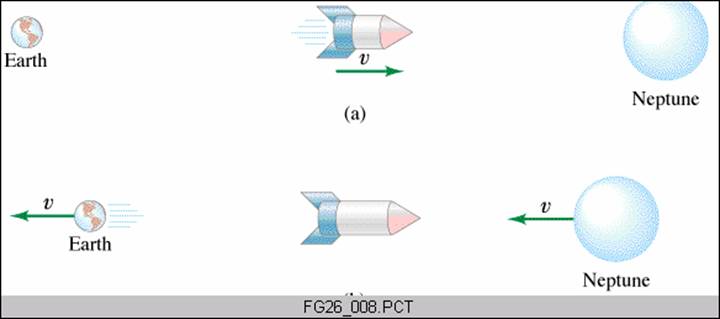
According to measurement from Earth (comparing clocks to those on the ship) the distance between the two planets is dEarth=v ΔtEarth , but according measurements on the spaceship the distance is dship=v Δtship. Therefore as seen from the ship the distance between the planets is smaller. Changing the frame of reference, the planets are passing by the ship, so the observer on the ship sees a smaller distance between the planets relative to an observer that is static relative to the planets.
|
dship = dEarth (Δtship / ΔtEarth) à dmoving = dstatic (1-v2/c2)1/2 |
So as seen by a static observer, a moving meter stick (lying parallel to the direction of motion) appears shorter as compared to a static meter stick.
- A moving tennis ball moving at high speeds looks like a pancake. At the speed of light the pancake looks like zero thickness.
- To a traveller moving at the speed of light, the distance between our solar system and the center of the galaxy (or any other distance) looks like zero.
- Passing by a painting or a house at high speeds they would look contracted horizontally.
- One could see the side of the house at the moment facing it while passing by it, because light from the side emitted at a slightly earlier time (and traveling a longer distance at the same speed as other light) just reaches the observer when facing the house, and while the house is not blocking the ray.
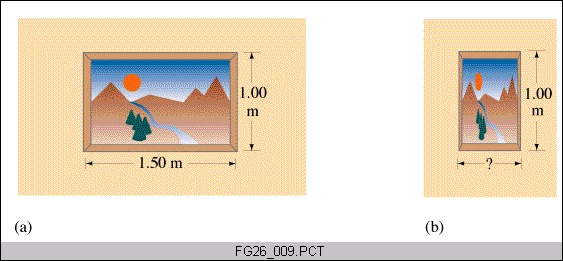
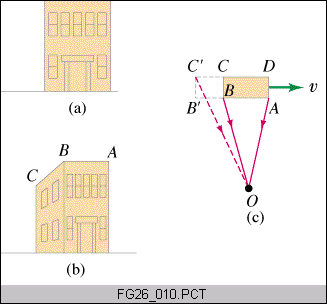
Conclusion: Time, like space, is not absolute, but they are inter-related. They both depend on the observer. Events that appear simultaneous in one frame of reference are not simultaneous in moving frames of reference. Each observer has his own space-time.
|
Space contraction: L=L0(1-v2/c2)1/2. Time dilation : t = t0/(1-v2/c2)1/2. |
|
T,L are as measured by static observer watching a moving clock or a moving stick t0 ,L0 are as measured by observer that moves together with the clock or with the stick |
Energy, momentum, mass and relation to velocity.
The mass of a particle at rest is called its rest mass m0. When the particle moves it has momentum p and energy E=(p2c2+m02c4)1/2. Think of a right triangle with hypotenuse E and perpendicular sides pc and m0c2. The speed of the particle v/c is given by the ratio of the side pc to the hypotenuse E. From the triangle we see what happens as one side gets much larger than the other, you approach the extreme relativistic (fast) or extreme non-relativistic (slow) limits

pc E=(p2c2+m02c4)1/2 ( = mc2 equivalent mass )
m0c2 rest energy
The particle at rest (p=0) has energy E=m0c2. The speed of the particle is given by v/c=(cp/E). Therefore (from the triangle) the maximum v is c, and it can be attained only by massless particles m0=0. A massless particle cannot stop since v/c=1.
- The maxium attainable speed is the speed of light. Light is described as a massless particle (the photon). Any particle that has zero mass cannot slow down and must move with the speed of light. The neutrino is another particle whose mass is zero or almost zero, hence it moves at (or almost at) the speed of light.
- A particle that has non-zero rest mass m0 can never attain the speed of light although it can come closer and closer to it as its momentum is increased. Thus, macroscopic objects that have huge masses have a hard time attaining large enough energies, and therefore move at speeds much smaller than the speed of light.
- A summary of the formulas
|
momentum p =mv = m0v / (1-v2/c2)1/2 |
energy E E=(p2c2+m02c4)1/2 (hypotenuse) = mc2 = m0c2 / ( 1-v2/c2)1/2 |
speed v v=p/m
|
|
fast (triangle tall and skinny) |
fastest (m0=0 or p=infinite, not
practical) |
maximum speed |
|
slow (triangle short and fat) |
E=m0c2+m0v2/2
(second term like KE Newton) |
v=p/m0 |
The energy of a particle increases as its momentum increases E=(p2c2+m02c4)1/2 (equivalently when its velocity increases E = m0c2 / ( 1-v2/c2)1/2). The equivalent mass m satisfies E= mc2 with m= m0 / ( 1-v2/c2)1/2 . As the velocity increases the equivalent mass increases as shown.
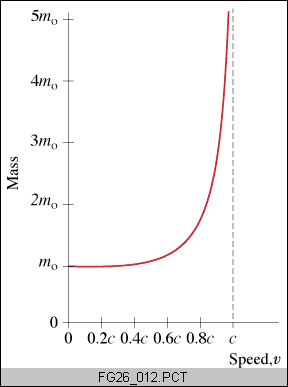
E=mc2 . Energy and mass are two facets of the same thing.
Mass can be created from energy, e.g. high frequency photon near nucleus creates electron + positron out of the vacuum.
Mass dissapears to create energy, e.g. electron+positron beams at SLAC annihilate to give photons, those can convert to other matter.
Other examples are fission and fusion. Energy from the sun ! Energy from nuclear reactors.
Consequences of Einstein's Theory of Special Relativity
Suppose that Einstein is right: the speed of light is measured to be the same by observers in all inertial frames. What does that mean? Well, consider a few simple situations.
Blue Man stands in a room. He decides to measure the height of his room by bouncing a light beam off the ceiling, and measuring the time it takes to return.
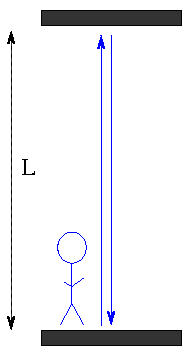
The height of the room is L, and the light beam travels at c, so the time it takes for the beam to go there and back is
2*L
t(blue) = -----
c
So far, so good.
Now, consider another observer: Red Man. Blue Man is in a frame which zooms past Red Man at a constant velocity v. As Red Man watches the Blue Man and his room go by, he also measures the distance travelled by the light beam.
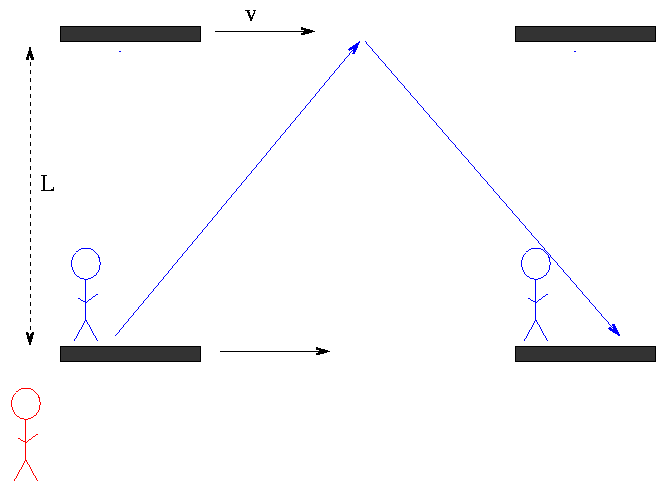
What distance does the light beam travel, according to Red Man?
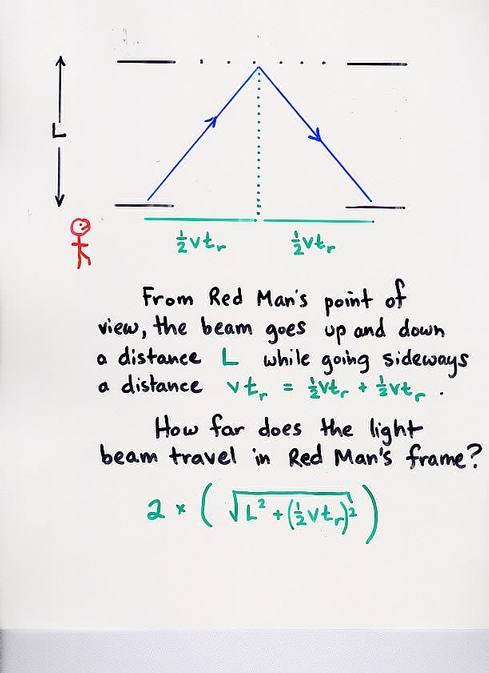 Viewgraph 1
Viewgraph 1
Now, if Red Man and Galileo were standing together and watching the beam, Galileo would say,
Behold! The room moves past us sideways at speed v, carrying the light with it. So the light beam travels faster than usual: it has a vertical component of 300,000,000 m/s, plus a horizontal component of v, and thus a total speed of
speed of light beam = sqrt ( 300,000,000*300,000,000 + v*v )The time it takes to reach the ceiling of the room and bounce back is, naturally, the same
2 * L time to go and return = ------- cthat Mr. Blue Man measured.
But if Einstein were present, he would disagree:
Actually, the light beam travels at exactly the same speed,
speed of light beam = 300,000,000 m/sfrom both our point of view, as we watch the room fly past us, or from Mr. Blue Man's point of view, inside the room. It is the time taken to make the trip which changes, not the speed of light.
So, according to Einstein, how long does the light beam take to make its trip, as seen from the ground with Red Man?
 Viewgraph
2
Viewgraph
2
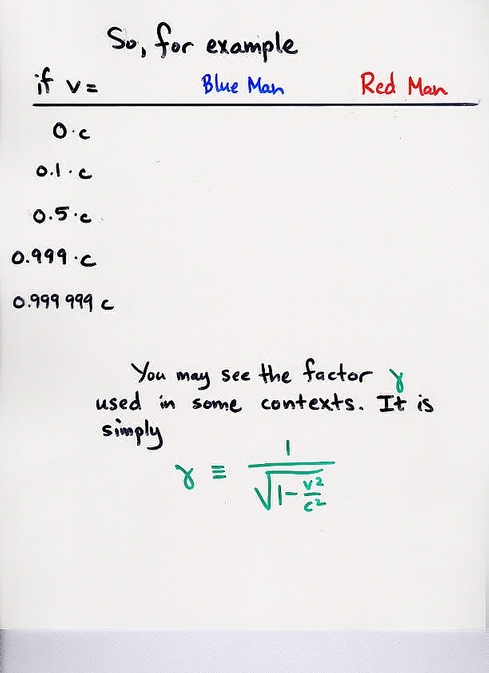 Viewgraph
3
Viewgraph
3
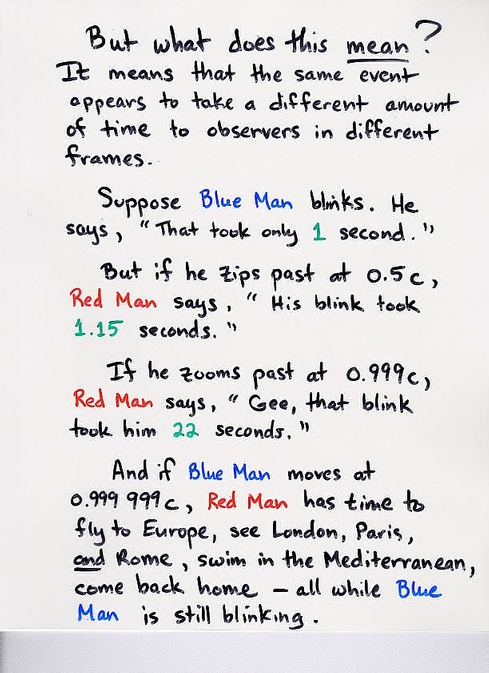 Viewgraph
4
Viewgraph
4
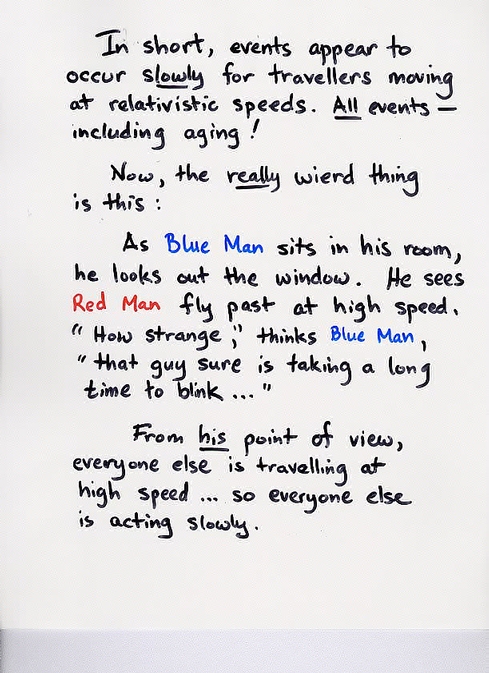 Viewgraph
5
Viewgraph
5
Tests of Time Dilation
 Viewgraph
6
Viewgraph
6
Assume that planes fly at about 500 mph = 250 m/s
relative to the ground.
Q1: How long does it take a plane to fly around
the world?
Q2: According to the stationary observer floating
above the North Pole,
what is the gamma factor for Joe?
what is the gamma factor for red plane?
what is the gamma factor for blue plane?
Q3: What is the difference between Joe's watch
and the red plane's clock when they meet?
Q4: What is the difference between Joe's watch
and the blue plane's clock when they meet?
Hiçbir yazı/ resim izinsiz olarak kullanılamaz!! Telif hakları uyarınca bu bir suçtur..! Tüm hakları Çetin BAL' a aittir. Kaynak gösterilmek şartıyla siteden alıntı yapılabilir.
The Time Machine Project © 2005 Cetin BAL - GSM:+90 05366063183 -Turkiye / Denizli
Ana Sayfa /
index /Roket bilimi /![]() E-Mail /CetinBAL/Quantum Teleportation-2
E-Mail /CetinBAL/Quantum Teleportation-2
Time Travel Technology /Ziyaretçi Defteri /UFO Technology/Duyuru
